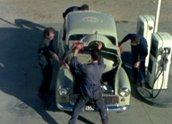

This Woman is Not a Car (1982)
Synopsis
This Woman is Not a Car is a suburban horror film that comments directly and humorously on the 1970s Australian male’s confusion about cars and women being objects of desire.
A depressed wife and mother (Pauline Sedgewick), whose reality is starting to fracture into fantasy, drives her children to the beach. On the return journey she stops at a service station to fill up with petrol. Four mechanics eye her off and, as one of them walks towards her car, a full-blown erotic fantasy develops.
Curator’s notes
This Woman is Not a Car is the film version of artist and filmmaker Margaret Dodd’s sculpted interpretations of the original FX Holden and how women are objectified by men. In 1982 she was already well known for her sculpture series of ceramic cars dressed as brides, mothers and babies. Like other feminist artists of the time, Dodds was exploring how women were trapped in narrowly defined roles of wives, mothers and sex objects.
Described by Glenys Rowe as 'the quintessential Australian horror movie’, This Woman is Not a Car is an imaginative examination of suburbia and sexual violence. It predated other films about the dark side of suburbia made in the 1980s. David Lynch’s feature Blue Velvet was made four years later in 1986.
Margaret Dodd sets the scene of suburban isolation and despair brilliantly in the first few minutes of This Woman is Not a Car. Almost immediately there is a hint of things to come when 'the wife’s’ dressing gown comes apart to reveal a car headlight instead of a breast. A picnic at the beach could be a welcome escape from the routine of motherhood but the kids’ laughter becomes loud and unrelenting and the beach is uninviting. A long, fast tracking shot pulls away from the picnic as the children devour their pies (mother?). This is the moment when the woman begins to lose contact with reality (see clip one).
On the way back, stopping to get petrol at an isolated service station, a fantasy takes shape. Four car mechanics stare at the woman as though she is their prey. What follows is a powerful scene that incorporates eroticism, humour, intimidation and violence. One man moves toward her but then veers off to make love to the car – his true object of desire. At first the analogy between the car and the woman (set up by the glimpse of the headlight replacing the woman’s breast earlier) takes on an erotic quality and it could be the woman’s fantasy. But as his mates, car fetishists, move in, they gang rape their love object, the car (see clip two). This sets off a horror sequence from the 'woman as victim’ point of view as the woman questions the meaning of marriage and sexuality. The final scenes of the woman giving birth to a ceramic car take this fantasy to its logical, painful and absurd conclusion.
In this film, the filmmaker successfully and dramatically undermines the Australian dream of the time. The suburban ideal of marriage, children and conformity is turned into a nightmare. The woman character is trapped inside this male-dominated culture. But the filmmaker is not. Margaret Dodd succeeds in making her feminist point to the audience that this woman (and others like her) is not a car!
Distributed by the AFI, This Woman is Not a Car was screened in the 1983 Australian Perspecta, the 1983 Sceaux and Tyneside Film Festivals and the 1984 season of 'Australian Alternatives’ at the NFT in London.
- Overview
- Curator’s notes
- Video 2 clips
- Principal credits
- Find a copy
- Make a comment
- Map
- Add your review



